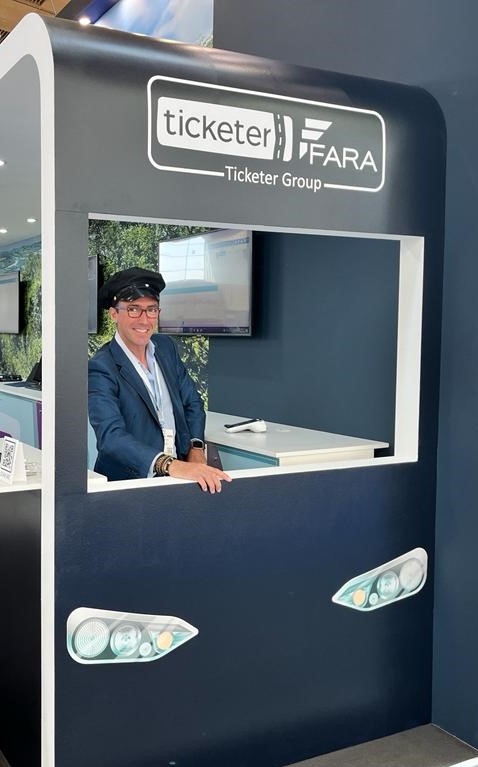 It was a busy few days at the IT-TRANS conference in Karlsruhe, Germany, this month, filled with important discussions, fantastic guest speakers and plenty of attendees. There was lots to take in! We’ve shared our top takeouts below in case you missed out.
It was a busy few days at the IT-TRANS conference in Karlsruhe, Germany, this month, filled with important discussions, fantastic guest speakers and plenty of attendees. There was lots to take in! We’ve shared our top takeouts below in case you missed out.
Antonio Carmona, Ticketer’s International General Manager and Head of UK Sales, tells us about what he saw and heard at IT-TRANS:
What was the hottest topic?
Data and Analytics – Many of the speakers talked about data and analytics for the transport industry. We all know that the massive amounts of data available from multiple suppliers is mind-blowing and often under-utilised. The common knowledge is that the more you can understand about your network, the services, passengers and what they want, you can then define the service and make it the best it can be. The one thing that is certain is that there is so much data available. You very often find there are vendors with lots of kit to capture data, but all from different suppliers with multiple systems and nothing to coordinate all the data from these systems together. At FARA, a Ticketer Group company in the Nordics, we’ve tied together an eco-system of hardware and software to make everything better for operators and customers alike. More will follow on this later in the year – keep your eyes peeled!
What innovation excited you the most?
Seeing how our own innovations can add value to operators was really rather exciting. Our plans for data sharing which are already in place at FARA in the Nordics and coming soon to the UK, is allowing partners to come together to deliver operator benefits. It’s a great opportunity for our industry to accelerate ‘Connected Bus’ thinking and to provide opportunities to future-proof operations.
We’ve been working hard to help come up with solutions to future-proof ticketing solutions and deliver operational efficiencies. Ultimately, we are here to help operators operate better – it is our key priority. We believe the future is a Connected Bus, where hardware and software solutions are integrated to provide a more seamless operation – and passenger experience.
It’s an exciting new horizon in terms of what a Connected Bus could offer. It opens up new possibilities of operational management across the various equipment in play on any one single bus. Potential consolidation of onboard equipment and communication devices could save both time and money.
It also provides an opportunity to automate manual processes and to create value that is better than the sum of its parts, by combining equipment and systems so they can benefit from each other. What if operators could integrate their ticketing systems with on-board CCTV and telematics? Imagine the improved solutions this Connected Bus prospect could provide.
And it doesn’t stop there, it’s much more than just consolidating data communications. Think of the improved data packages you could have without relying on multiple SIM providers.
The ultimate view is that punctuality, passenger satisfaction, and costs all benefit from integrated and accurate real-time operational data.
The future vision is that buses will be manufactured with the physical infrastructure wiring already in place, minimising the complexity of installations, and built with an architecture that very much is modelled around interconnectivity of components on a bus through a plug and play type of network. This work is something that is already happening in Europe with the ITxPT (Information Technology for Public Transport) standard leading the charge, and we believe it will be introduced to the UK market over the coming year.
W hat was the biggest talking point on the Ticketer Group stand?
hat was the biggest talking point on the Ticketer Group stand?
Contactless EMV – Apart from the excitement of being back at an event in person, contactless EMV was probably the most talked about topic around next generation ticketing and Account-Based Ticketing (ABT). To allow operators to build back after Covid, there was a lot of discussion on how simplifying fares and removing barriers to public transport is a must. Contactless EMV and Tap Off Readers (TORs) are providing a much simpler way to travel by bus. For normal contactless transactions passengers don’t have to plan their journeys anymore – they can just tap and go!
With the increasing introduction of fare capping, passengers know they always get the best price, even if they are now travelling less frequently. Many operators have seen a big increase in contactless transactions, particularly over the past two years, accelerating that trend even quicker than expected. TORs are now being seen as a necessity because of the need to offer simpler fares and allowing passengers the opportunity to get the best price no matter how often they travel, and to encourage them to travel more. Operators then get the benefits of faster boarding times and reduced transaction costs.
 What were people surprised to see?
What were people surprised to see?
Ticketer Handhelds – People were surprised that they get the same functionality on a neat little piece of kit as they do on the Electronic Ticketing Machine (ETM). Great things really do come in small packages! From what you would hope to get from a handheld device in terms of accepting contactless cards and smartcards all the way through to personalised tickets, it’s one of our fastest growing areas of interest. For operators, the Ticketer Handheld does exactly the same as Ticketer standard ETM but with the added bonus of being totally mobile. For some operators, it’s starting to revolutionise their business and helping their post-Covid recovery.
What were your top 3 takeaways from the conference?
1. Information Remains Key – Public Transport Operators and Local Authorities are placing increasing importance on data insight. With a vast amount of data available with an ever increasing amount of onboard equipment, access is needed to all those systems. From monitoring that everything is operating correctly, through to continually identifying ways operations can be improved – data insight was one of the hottest topics and will continue to be so for a long time.
2. Electrified Integration – Increasing numbers of authorities and operators are converting to electric vehicles, however they’re often forgetting the most important tools for implementation. Monitoring critical information such as battery levels and remaining driving distance will need to be a priority for any fleet moving towards electrification, as will finding the right solutions and hardware to support this activity.
3. SaaS is Stepping Up – An interesting trend has finally arrived within the public transport industry, with more operations than ever before converting to a Software as a Service (SaaS) based business model. As a result, authorities and operators will need to prioritise onboarding effective Cloud-based solutions to meet newly established standards. Using that cloud-based technology allows even the smallest operator to have access to the same products for ticketing and real-time as larger operators so they can transform their business without high costs or unnecessary barriers to entry.

